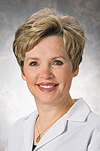Skin cancer is the most common form of human cancer. The term "skin cancer" refers to 3 different conditions: basal cell carcinoma (BCC), squamous cell carcinoma (SCC) and melanoma.
BCC and SCC are referred to as nonmelanoma skin cancers and are the most common forms of skin cancer. They are rarely life-threatening but can be locally destructive to tissue. Melanoma is generally the most serious form of cancer because it can metastasize (or spread) throughout our body quickly.
Patrick M. Killian, M.D., is a Mohs Cancer Surgeon and board-certified Dermatologist skilled in all aspects of dermatological care. He serves as Mohs Cancer Surgeon at Trillium Creek Dermatology & Surgery Center.
Mohs Micrographic Surgery
Since the 1980s, the most successful procedure for removing nonmelanoma skin cancers has been Mohs Micrographic Surgery. The Mohs technique was originated by Dr. Frederick Mohs, a general surgeon from Wisconsin during the 1930s. Since then it has been modified to the procedure that was started in the 1980s and continues today. The goal is to completely eradicate and remove nonmelanoma skin cancers, while at the same time, minimizing the amount of normal tissue that must be sacrificed.
What to Expect from Mohs Surgery
The area in which skin cancer is found is numbed using a local anesthetic. The visible tumor is debulked (or scraped) with a curette, an instrument that doesn't tear normal tissue. Your Trillium Creek Mohs surgeon then removes 1 mm around the tumor and the tissue sample is sent to our in-house laboratory for processing. It takes only 5-10 minutes for your Mohs surgeon to remove the first sample, at which time you will be directed to the waiting room with a bandage over your wound.
Processing the sample takes about 1 to 1-1/2 hours. Once the sample is processed, it is examined under the microscope to check multiple sections, making sure all of the cancerous cells have been removed. If cancerous cells are still present, your Mohs surgeon must go back and remove more tissue until the margins are clear upon examination. Once the margins are clear, the wound is sutured and dressed and you are given complete home care instructions. The average time spent at the clinic by a Mohs patient is 2-6 hours, depending on the case.
You should take it easy for a day and refrain from strenuous physical activity or anything that would increase blood pressure or heart rate. This will help control bleeding and swelling which helps to control pain. Most patients resume their normal routine within a day. Forty-eight hours after surgery, you will be instructed to remove the dressing, clean the wound with soap, water and peroxide, apply Vaseline and rebandage the area. Within a week you must return to our offices have the sutures removed.
Because Mohs surgery removes the smallest amount of tissue possible, the size of your scar is minimized. Also, more importantly, all cancerous cells have been removed.
90% of Mohs surgeries are done to the face, and half of those are on the nose and ears. If there is a need to excise into the cartilage of the nose or ears, the site can be painful once the local numbing wears off. However, the entire area is anesthetized and some people are so comfortable, they fall asleep on the operating table. Over-the-counter pain relievers are usually all that is needed to control pain after the procedure.
What Makes Mohs So Effective?
With typical surgical excisions, the pathologist "bread loaf" or slices the specimen vertically, like a loaf of bread. Using this technique, the pathologist is only sampling the margins of the tissue, so only 1 percent of the specimen is being examined. With Mohs surgery, 100% of the specimen is examined, which explains why Mohs surgery results in much higher cure rates than other forms of surgery.
Skin Cancer prevention
The best way to avoid skin cancer is prevention, and sun protection is a cornerstone of skin cancer prevention.
When the immune system in your skin is working at 100%t efficiency, it clears away borderline precancerous areas and prevents them from turning into growths you can feel or see. But ultraviolet light from the sun temporarily suppresses the immune system in your skin. When you expose your skin to the sun without protection, you hinder your immune system's natural ability to clear away small clusters of precancerous cells. Whether you’re burning or just tanning, you are increasing your risk of precancerous growths turning into skin cancer.
Sun protection during every season is paramount. Some people have the misconception that because they tan easily and don't burn, they dont have to worry about skin cancer. It's true that they may not be at high risk, but they are at risk nonetheless.
It's never too late to start protecting your skin. Just because you haven't in the past, doesn't mean your skin won't benefit from protection now. Trillium Creek offers sun protection products to safeguard your skin from the sun, and sunless tanning products for a safe, natural-looking alternative to sun exposure.
Call the Mohs Skin Cancer Center to schedule an appointment at: 330.721.9990.
